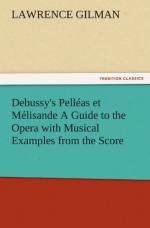The radicalism of the music was fully appreciated at the time of the first performances in Paris. To the dissenters, Debussy’s musical personages were mere “stammering phantoms,” and he was regaled with the age-worn charge of having “ignored melody altogether.” Debussy has defended his methods with point and directness. “I have been reproached,” he says, “because in my score the melodic phrase is always in the orchestra, never in the voice. I tried, with all my strength and all my sincerity, to identify my music with the poetical essence of the drama. Before all things, I respected the characters, the lives of my personages; I wished them to express themselves independently of me, of themselves. I let them sing in me. I tried to listen to them and to interpret them faithfully. I wished—intended, in fact—that the action should never be arrested; that it should be continuous, uninterrupted. I wished to dispense with parasitic musical phrases. When listening to a work, the spectator is wont to experience two kinds of emotions which are quite distinct: the musical emotion, on the one hand; the emotion of the character [in the drama], on the other; generally they are felt successively. I have tried to blend these two emotions, and make them simultaneous. Melody is, if I may say so, almost anti-lyric, and powerless to express the constant change of emotion or life. Melody is suitable only for the song (chanson), which confirms a fixed sentiment. I have never been willing that my music should hinder, through technical exigencies, the changes of sentiment and passion felt by my characters. It is effaced as soon as it is necessary that these should have perfect liberty in their gestures as in their cries, in their joy as in their sorrow.” However much one may hesitate to subscribe to Debussy’s generalities, the final justification for his procedure is in the fact that it is ideally suited to its especial purpose,—the tonal utterance of Maeterlinck’s rhymeless, metreless, and broken phrases. To have set them in the sustained arioso style of Tristan und Isolde would have been as impossible as it would have been inept. As it is, the writing for the voices in Pelleas never, as one might reasonably suppose, becomes monotonous. The achievement—an astonishing tour de force, at the least—is as artistically successful as it is unprecedented in modern music.
In his treatment of the orchestra, Debussy makes a scarcely less resolute departure from tradition. There is little symphonic development in the Wagnerian sense. His orchestra reflects the emotional implications of the text and action with absolute and scrupulous fidelity, but suggestively rather than with detailed emphasis. The drama is far less heavily underscored than with Wagner; the note of passion or of conflict or of tragedy is never forced. His personages love and desire, exult and hate and die, with a surprising economy of vehemence and insistence. Yet, unrhetorical as the music is, it is never pallid; and in such truly climacteric moments as that of Golaud’s agonized outbreak in the scene with Melisande, in the fourth act, and the ecstatic culmination of the final love-scene, the music supports the dramatic and emotional crisis with superb competency and vigor.




